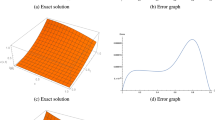Abstract
A new finite element method, which is the characteristic-based operator-splitting (CBOS) algorithm, is developed to solve Navier-Stokes (N-S) equations. In each time step, the equations are split into the diffusive part and the convective part by adopting the operator-splitting algorithm. For the diffusive part, the temporal discretization is performed by the backward difference method which yields an implicit scheme and the spatial discretization is performed by the standard Galerkin method. The convective part can be discretized using the characteristic Galerkin method and solved explicitly. The driven square flow and backward-facing step flow are conducted to validate the model. It is shown that the numerical results agree well with the standard solutions or existing experimental data, and the present model has high accuracy and good stability. It provides a prospective research method for solving N-S equations.
Similar content being viewed by others
References
Christie I, Griffiths D F, Mitchell A R, et al. Finite element methods for second order differential equations with significant first derivatives. Int J Num Meth Eng, 1976, 10(6): 1389–1396
Brooks A N, Hughes T J R. Streamline upwind/Petrov-Galerkin formulation for convection dominated flows with particular emphasis on the incompressible Navier-Stokes equations. Comp Meth Appl Mech Eng, 1982, 32: 199–259
Hughes T J R, Franca L P, Hulbert G M. A new finite element formulation for computational fluid dynamics: VIII. The Galerkin/least-squares method for advective diffusive equations. Comput Meth Appl Mech Eng, 1989, 73(2): 173–189
Donea J. A Taylor-Galerkin method for convective transport problems. Int J Num Meth Eng, 1984, 20(1): 101–119
Zienkiewicz O C, Nithiarasu P, Codina R, et al. The characteristic-based-split procedure: an efficient and accurate algorithm for fluid problems. Int J Num Meth Fluids, 1999, 31(1): 359–392
Zienkiewicz O C, Taylor R L. The Finite Element Method. Oxford: Butterworth Heinemann, 2000
Douglas J J, Russell T F. Numerical methods for convection dominated diffusion problems based on combining the method of characteristics with finite element or finite difference procedures. Siam J Num Anal, 1982, 19(5): 871–885
Yanenko N N. The Method of Fractional Steps. New York: Springer, 1971
Timmermans L J P, Van De Vosse F N, Minev P D. Taylor-Galerkin-based spectral element methods for convection-diffusion problems. Int J Num Meth Fluids, 1994, 18(9): 853–870
Ying L A. Viscosity splitting method in bounded domains. Sci China Ser A, 1989, 32(8): 908–921
Cao Z X, Wei L Y. An operator-splitting algorithm for solutions of Burger’s equations (in Chinese). J Wuhan U Hydr Elec Eng, 1991, 24(2): 193–201
Sun C, Qin S J. Analysis of operator splitting semi-explicit finite element method for time-dependent linear convective-diffusion problems (in Chinese). Math Num Sinica, 2003, 25(1): 23–34
Zienkiewicz O C, Codina R. A general algorithm for compressible and incompressible flow—Part I. The split, characteristic based scheme. Int J Num Meth Fluids, 1996, 20: 869–885
Zhang B Z. The Finite Element Method in Fluid Dynamics (in Chinese). Beijing: China Machine Press, 1984
Taylor C, Hughes T G. Finite Element Programming of the Navier-Stokes Equations. Swansea: Pineridge Press, 1981
Ghia U, Ghia K N, Shin C T. High-Re solutions for incompressible flow using the Navier-Stokes equations and a multigrid method. J Comput Phys, 1982, 48(3): 387–411
Hung L, Parviz M, John K. Direct numerical simulation of turbulent flow over a backward-facing step. J Fluid Meth, 1997, 330: 349–374
Wang X H, Fan H M, He Z Y. Numerical simulation of backward-facing step flow (in Chinese). Chin J Comput Mech, 2003, 20(3): 361–365
Wang B, Zhang H Q, Yu J F, et al. Numerical simulation of large eddy structures evolution behind backward-facing step (in Chinese). Chin Q Mech, 2003, 24(2): 166–173
Denham M K, Patrik M A. Laminar flow over a downstream-facing step in a two-dimensional flow channel. Trans Inst Chem Engs, 1974, 52: 361–367
Author information
Authors and Affiliations
Corresponding author
Rights and permissions
About this article
Cite this article
Wang, D., Wang, H., Xiong, J. et al. Characteristic-based operator-splitting finite element method for Navier-Stokes equations. Sci. China Technol. Sci. 54, 2157–2166 (2011). https://doi.org/10.1007/s11431-011-4444-7
Received:
Accepted:
Published:
Issue Date:
DOI: https://doi.org/10.1007/s11431-011-4444-7




